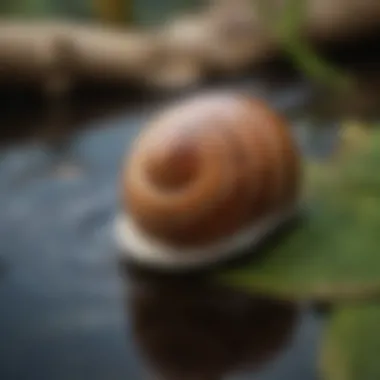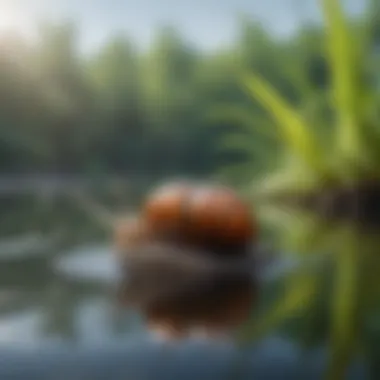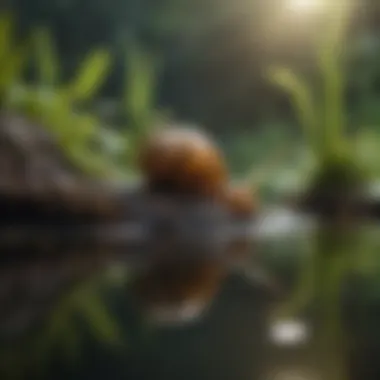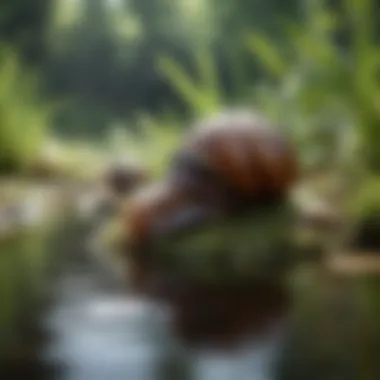Unveiling the Intriguing World of Freshwater Pond Snails


Animal Species Profile
Freshwater pond snails are fascinating creatures that populate a variety of aquatic environments, adding to the complexity and diversity of underwater ecosystems. These diminutive gastropods exhibit a remarkable array of physical characteristics and behaviors that are essential to their survival in their natural habitats.
Physical Characteristics and Appearance
Freshwater pond snails typically have a conical shell that houses their soft body, providing them with protection from predators and environmental conditions. Their shells come in various shapes, sizes, and colors, reflecting the species' diversity. Additionally, these snails possess a muscular foot used for locomotion and a distinct head bearing sensory tentacles.
Natural Habitat and Distribution
These resilient snails can be found in ponds, lakes, streams, and other freshwater bodies worldwide. They thrive in both still and flowing waters, relying on aquatic plants and algae for sustenance. Their distribution is vast, with different species adapting to specific geographical regions and environmental conditions.
Behavior and Social Interactions
Freshwater pond snails exhibit intriguing behaviors such as grazing on algae, scavenging for food, and reproducing through varied mechanisms like egg-laying or live birth. While they are not typically social creatures, some species display interesting interactions with conspecifics and other aquatic organisms, contributing to the intricate dynamics of aquatic ecosystems.
Introduction


Freshwater pond snails are captivating creatures that inhabit a unique ecological niche within aquatic systems. Their presence may often go unnoticed, yet these small invertebrates play a significant role in maintaining the delicate balance of freshwater ecosystems. Understanding the intricacies of freshwater pond snails is essential for appreciating the interconnected web of life that thrives beneath the water's surface. By delving into the world of these mollusks, we gain insights into their anatomy, behavior, and ecological importance, shedding light on a lesser-explored aspect of aquatic biodiversity.
What are Freshwater Pond Snails?
Freshwater pond snails, belonging to the Gastropoda class, are a diverse group of mollusks that reside in various freshwater bodies such as ponds, lakes, and slow-moving streams. These gastropods exhibit a range of shell shapes and sizes, adapting to their specific habitats. Despite their small size, freshwater pond snails contribute substantially to nutrient cycling within aquatic environments, playing a vital role in the local ecosystem's health and stability. Snails display remarkable resilience in adapting to fluctuating environmental conditions, showcasing specialized feeding habits and reproductive strategies that ensure their survival in diverse habitats. Their presence enriches freshwater ecosystems, serving as indicators of environmental health and providing valuable insights into the intricate dynamics of these aquatic landscapes.
Anatomy of Freshwater Pond Snails
Freshwater pond snails' anatomy plays a crucial role in understanding the inner workings of these intriguing creatures in the realm of aquatic ecosystems. By delving into the intricate details of their physical structure, enthusiasts can gain valuable insights into how they navigate their watery habitats and interact with other organisms. Anatome of Freshwater Podn Snalis highlits key elements such as the intricate shel wsensitivity she
Habitat and Distribution
Freshwater pond snails, the unsung heroes of aquatic ecosystems, are intricately linked to their habitat and distribution patterns. Understanding these aspects is crucial in unraveling the intricate tapestry of these fascinating creatures' lives. Their habitat encompasses a diverse array of freshwater ecosystems, ranging from serene ponds to meandering rivers, each offering a unique environment for these snails to thrive. It is within these water bodies that freshwater pond snails find sanctuary, where they play a pivotal role in maintaining the delicate balance of underwater life.
Delving deeper into their distribution, freshwater pond snails can be found in a myriad of locations across the globe. They are not confined to specific regions but are rather adaptable to various freshwater habitats, showcasing their resilience and ability to survive in different conditions. Their distribution is influenced by a combination of factors, including water quality, temperature, and nutrient availability. By exploring the habitats and distributions of freshwater pond snails, we gain insights into the complex interactions shaping their existence.
Freshwater Ecosystems
Freshwater ecosystems serve as the stage where freshwater pond snails perform their vital ecological roles. These ecosystems are dynamic, ranging from tranquil ponds to rushing streams, each harboring a wealth of biodiversity. Freshwater pond snails inhabit these ecosystems, contributing to nutrient cycling and serving as a food source for other aquatic organisms.


Within freshwater ecosystems, pond snails filter water, consuming algae and detritus, thus helping maintain water quality. Their presence influences the availability of nutrients, impacting the growth of aquatic plants and the overall health of the ecosystem. By thriving in various freshwater ecosystems, pond snails demonstrate their adaptability and significance in the intricate web of aquatic life. Understanding their role within freshwater ecosystems is key to appreciating the interconnectedness of all organisms in these dynamic environments.
Behavior and Feeding Patterns
In the realm of freshwater pond snails, behavior and feeding patterns take center stage as crucial elements shaping their existence. Understanding these facets not only unravels the inner workings of these aquatic organisms but also sheds light on their significance in the ecosystem. Behavior encompasses a wide array of actions exhibited by pond snails, from feeding strategies to social interactions. Feeding patterns, on the other hand, dictate how these creatures obtain nutrients to sustain their life processes. By delving into the intricate details of behavior and feeding patterns, enthusiasts gain profound insights into the evolutionary adaptations and survival strategies employed by freshwater pond snails.
Movement Patterns
Dietary Preferences
Reproductive Strategies
Freshwater pond snails' reproductive strategies play a vital role in the proliferation and sustainability of their population within aquatic ecosystems. These strategies are intricately linked to the species' survival and contribute significantly to the biodiversity of freshwater habitats. Understanding the nuances of reproductive strategies provides insight into the evolutionary adaptations specific to pond snails, shedding light on their resilience and ability to thrive in varying environmental conditions. By exploring these strategies, we unravel the complex web of life that freshwater pond snails are woven into, showcasing their adaptability and reproduction methodologies.
Egg Deposition
Egg deposition marks a crucial phase in the reproductive cycle of freshwater pond snails. This process entails the careful selection of favorable sites for laying eggs to ensure optimal conditions for successful hatching and offspring development. Pond snails exhibit interesting behaviors during egg deposition, showcasing maternal instincts and instincts to safeguard the next generation. The choice of egg-laying sites reflects the adaptability and survival instincts of these remarkable creatures, highlighting their ability to adapt to changing environmental parameters and utilize available resources efficiently. Observing the egg deposition process provides valuable insights into the reproductive strategies of freshwater pond snails, offering a glimpse into their life cycle and parental care mechanisms.
Ecological Importance


Freshwater pond snails are not merely quaint inhabitants of aquatic environments; their role in nutrient cycling within freshwater ecosystems is paramount. These diminutive creatures act as natural recyclers, breaking down organic matter and releasing essential nutrients back into the water. Through their feeding and excretory habits, pond snails play a pivotal role in maintaining water quality and promoting the overall health of the ecosystem.
Nutrient Cycling
In the intricate web of life within freshwater habitats, nutrient cycling stands out as a fundamental process that ensures the sustainability of these ecosystems. Freshwater pond snails, with their voracious appetites for algae and decaying plant matter, contribute significantly to nutrient cycling. By consuming and digesting organic material, they release valuable nutrients such as nitrogen and phosphorus back into the water column. This essential recycling process supports the growth of aquatic plants and sustains diverse life forms within the ecosystem.
Food Source
Freshwater pond snails serve as a vital food source for various aquatic organisms, forming a crucial component of the intricate food chain in freshwater ecosystems. Their presence sustains predators like fish, amphibians, and birds, ensuring a balanced ecosystem where each organism plays a unique role. Additionally, pond snails themselves are adept at adapting to different feeding conditions, showcasing a diverse array of dietary preferences. From algae to detritus, these opportunistic feeders effectively utilize available food sources, contributing to the dynamic balance of energy flow within the ecosystem.
Threats and Conservation
In the enthralling exploration of freshwater pond snails, a crucial aspect demanding meticulous attention is the realm of Threats and Conservation. These diminutive yet ecologically significant creatures face a multitude of challenges in their precarious existence. Understanding the pivotal role of Threats and Conservation in this narrative unveils the delicate balance of nature that hinges on our awareness and proactive measures to safeguard these intriguing organisms.
The worrisome specter of Habitat Loss looms large over freshwater pond snails, posing a considerable risk to their populations. As urbanization encroaches upon natural habitats, these resilient mollusks encounter diminishing living spaces and food sources. The degradation of water quality and disruption of ecological balance further exacerbate the plight of these organisms, necessitating urgent attention and conservation efforts to mitigate the impacts of habitat loss.
In a similar vein, Pollution Impacts emerge as a significant menace to the well-being of freshwater pond snails. The insidious infiltration of pollutants into aquatic environments poses grave threats to these delicate creatures, disrupting their reproductive cycles, impairing their physiological functions, and ultimately jeopardizing their survival. Understanding the intricacies of pollution impacts on pond snails underscores the pressing need for comprehensive conservation strategies and stringent environmental regulations to safeguard their habitats and ensure their continued existence.
Conclusion
In the realm of freshwater pond snails, the conclusion serves as a pivotal point, consolidating the refined details about these intriguing creatures. Understanding the significance of freshwater pond snails goes beyond mere observation; it delves into the intricate balance of the aquatic ecosystem. By appreciating their role in nutrient cycling and as a significant food source, we gain a profound insight into the web of life in freshwater environments. Conservation efforts aimed at protecting their habitats become crucial, considering the peril they face due to habitat loss and pollution. The conclusion encapsulates the essence of freshwater pond snails, urging us to value these tiny yet impactful beings in the grand tapestry of nature.
Appreciating Freshwater Pond Snails
Embarking on a journey to appreciate freshwater pond snails unravels a world rich in wonder and scientific marvel. These diminutive gastropods, with their distinctive anatomy and behaviors, offer a window into the complexities of freshwater ecosystems. Inhabitants of diverse habitats, freshwater pond snails showcase unique movement patterns and dietary preferences, highlighting their adaptability to varied environments. Delving deeper unveils their crucial role in nutrient cycling, exemplifying their ecological importance. As we delve into appreciating freshwater pond snails, we develop a profound reverence for these unsung heroes of the aquatic world, fostering a deeper connection with the natural world around us.







